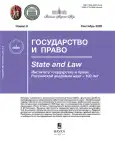Memorandum of understanding – legally a non-binding agreement
- Авторлар: Shinkaretskaya G.G.1
-
Мекемелер:
- Institute of State and Law of the Russian Academy of Sciences
- Шығарылым: № 9 (2025)
- Беттер: 132-141
- Бөлім: Law and international relations
- URL: https://bakhtiniada.ru/1026-9452/article/view/318300
- DOI: https://doi.org/10.31857/S1026945225090129
- ID: 318300
Дәйексөз келтіру
Аннотация
A significant increase in the number of international documents that do not have legal force creates uncertainty in the regulation of international relations. Of particular interest in this regard are memoranda of understanding, which resemble contracts in form, but are not contracts, so there can be no legal liability for their violation. But the State’s political commitment does not absolve it of responsibility completely; memoranda are subject to the pacta sunt servanda principle. The concept of estoppel is applicable to their action. The importance of memoranda lies in the fact that they serve as a preparatory stage for the formation of a “hard” rule, as well as for the crystallization of opinio juris in the process of forming a customary rule.
Авторлар туралы
G. Shinkaretskaya
Institute of State and Law of the Russian Academy of Sciences
Хат алмасуға жауапты Автор.
Email: gshink@yandex.ru
Moscow
Әдебиет тізімі
- Виноградова Е. В. История правовых идей и институтов // Труды ИГП РАН. 2024. Т. 19. № 1. С. 11–35.
- Кабышев О. А. MOU Соглашение/Меморандум о намерениях в международной торговле. 27 июня 2024 г. URL: https://dzen.ru/a/Zn1bw5pUSAH2N4_Y (дата обращения: 06.07.2025).
- Колосов Ю. М., Юзбашян М. Р. Вклад российской (советской) юриспруденции в становление и развитие международного космического права // Московский журнал международного права. 2012. № 4. С. 12–34.
- Сыскова Ю. Что такое соглашение о намерениях. URL: https://www.klerk.ru/buh/articles/558861/ (дата обращения: 05.07.2025).
- Талалаев А. Н. Право международных договоров. М., 2022. Т. 1. С. 24.
- Aust А. Modern Treaty Law and Practice. 3rd ed. ОUP, 2013. Pp. 28, 40–43, 51.
- Aust А. The Theory and Practice of Informal International Instruments // International and Comparative Law Quarterly. 1986. No. 35. P. 788.
- Boyle А. Soft Law in International Law-Making // Evans M.D. (ed). International Law. 5th ed. OUP, 2018. P. 135.
- Crawford J. Brownlie’s Principles of Public International Law. 9th ed. OUP, 2019. P. 400.
- Ginsburg T. Authoritarian International Law? // American Journal of International Law. 2020. P. 231.
- Hollis D. B. Binding and Non-Binding Agreements: Sixth Report, 96th Regular Session, 2–6 March 2020, Rio de Janeiro, Brazil, OEA/Ser.Q, CJI/doc. 600/20, 3 February 2020, Annex II: Draft OAS Guidelines for Binding and Non-Binding Agreements (With Commentary). P. 57, 58.
- Hollis D. B. Defining Treaties // Hollis D.B. (ed). The Oxford Guide to Treaties. 2nd ed. OUP, 2020. Pp. 24–29.
- Meyer A. Alternatives to Treaty-Making – Informal Agreements // Hollis D.B. (ed). The Oxford Guide to Treaties. 2nd ed. P. 65, 123.
- Peters W. The Global Compact for Migration: to sign or not to sign? // European Journal of International Law: Talk! 21 November 2018. URL: https://ejiltalk.org/the-global-compact-for-migration-to-sign-or-not-to-sign/, p. 3 (дата обращения: 06.07.2025).
- Regan D. H. Sources of International Trade Law // Besson S., d’Aspremont J. (eds). The Oxford Handbook on the Sources of International Law. OUP. 2017. P. 1058.
- Wouters А. International Law, Informal Law-Making, and Global Governance in Times of Anti-Globalism and Populism // Krieger H., Nolte G., Zimmermann A. (eds). The International Rule of Law: Rise or Decline? Oxford University Press, 2019. Pp. 248–250.
Қосымша файлдар









